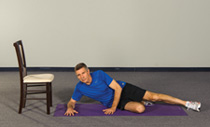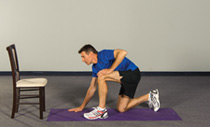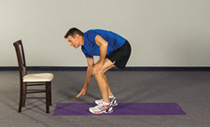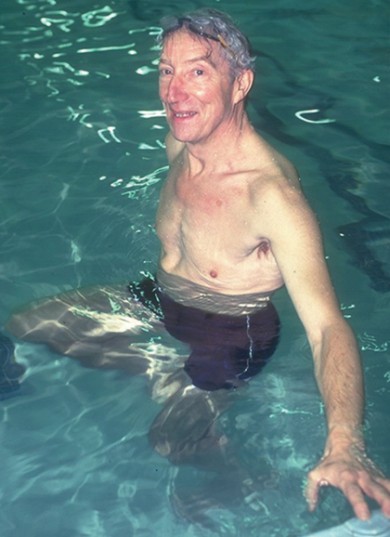Do you know how to compensate when you move?
by John C. Griffin, MSc
As people get older, they lose mobility. It is the first area where most older adults become impaired or disabled. In fact, De Brito and colleagues (2013) found that the ability to rise from the floor was a significant predictor of mortality in 51- to 80-year-olds. That means that people who could not get up after sitting on the floor were more likely to die early than others in their age group.
You have a role to play in preventing mobility loss
When you start to have trouble with certain tasks or activities, it is called a preclinical stage. The preclinical stage is a critical time for intervention. You can slow this down! Mobility problems can take one of three courses:
- Cessation: The worst option is to stop doing things that you used to do. For instance, someone who is starting to have trouble reaching up over their head might give up a favourite sport, like tennis or squash. This could lead to a more sedentary lifestyle, and that would lead to losing even more mobility.
- Retraining or repairing: It is often possible to regain performance in the area where mobility is becoming difficult. So many older adults are reluctant to visit a physiotherapist when they have a joint or muscle problem. But these health professionals can help you to regain mobility and step back into your active lifestyle. Or, they might help you to modify a task or activity so that you can still do it safely. This is called compensation.
- Compensation: Compensation can be both good and bad. If you alter a movement pattern so that you can still do it, but in the wrong way, it could lead to injury. For instance, someone who had weak leg muscles might start to bend from the waist to lift things, instead of bending their knees. That’s a sure-fire way to injure your back. On the other hand, a well-designed modification to a task or activity can slow down mobility decline. A good example of safe compensation is using Nordic poles when hiking to help with balance and reduce knee strain.
A good compensation strategy for getting up off the floor
Aging makes it harder to get down on the floor to do things like play with a child, clean out a cupboard, or do a floor exercise. We may have decreased upper and lower body strength, less range of motion, balance issues, or all three. We fear that we cannot get back up again without looking clumsy or losing our balance.
But researchers have described a technique that makes getting up off the floor much easier (Moxley, 2012). It might work for you, unless you have had a total knee or hip replacement or some other serious issue.

This chart shows the decline of physical function with age
How to do it:
- From your side, roll onto your stomach.
- Bring your knees in one by one to a position of all fours.
- Bring one leg up and forward under your chest, with your foot on the floor.
- Bring your hand to your thigh.
- Press your hand on one thigh as you bring the other leg up.
For safety: Place a sturdy chair nearby for support or in case you get dizzy.
1.)  2.)
2.) 
3.)  4. & 5.)
4. & 5.) 
References:
de Brito, L.B.B. et al. 2013. Ability to sit and rise from the floor as a predictor of all-cause mortality. European Journal of Preventive Cardiology 2014 July; 21(7):892-8.
Griffin, J.C. 2015. Client-Centered Exercise Prescription. Third edition. Champaign, Il.: Human Kinetics, www.HumanKinetics.com.
Moxley, C. 2012. Floor freedom: How to get up from the floor. Functional U (ICAA) 10(5): 1-10.
About the Author
John C. Griffin, MSc, , is an award-winning retired professor, private consultant, speaker, writer, and coach. He has authored more than 100 publications, including Client-Centered Exercise Prescription and chapters in the grade 12 Exercise Sciences and Healthy Active Living textbooks. Recently, he has conducted research on the functional mobility of older adults and developed a screening tool and exercise prescription algorithm. John worked with the Canadian Society for Exercise Physiology on the national certification for personal fitness trainers and is a national course conductor and examiner. Working with the National Fitness Leadership Advisory Council, John co-authored the first national standards for exercise leaders in Canada.
Click Here for print PDF file – Active Living – how to compensate when you move
The first step to success is saying yes
Change is very difficult for anyone. There will be challenges, whether you are changing your diet, starting a new activity, or trying to quit smoking. It is natural to feel frustrated, anxious, nervous, uncomfortable, or unsure.
The first step to success with any behaviour change is to be ready and willing to try it. Small steps add up to real changes over time. Be patient with yourself and celebrate your little successes along the way.
We all have the ability to learn throughout our life. Age is not a barrier. Scientists tell us that our brains continue to develop as we get older. But if we want to keep those new neurons working for us, we must challenge and exercise our brain each day. It’s just like building our muscles.
The stages of change
Making a change in your lifestyle is a series of stages you go through:
Stage 1
Not interested
Stage 2
Thinking about it
Stage 3
Preparing to make a change
Stage 4
Actually making a change
Stage 5
Sticking with it
Even when we have good intentions, sometimes it’s hard to stick with it, and that’s OK. But do try to take action. Why? Because action followed by a relapse is far better than taking no action at all.

Helpful hints
- Try a new activity or a new food. If you don’t like it, try something else.
- Lots of people relapse after they start to make a behavior change. If you do, just start again and keep on going.
- Try new things that make you think. Remember: what is good for your body is good for your brain.
This information is taken from Active Aging Canada’s resource, Your Personal Passport to Healthy Living, published in 2017. You can download the full document from our website.
Watch the ALCOA Video – Making Lifestyle Changes
Click Here for print PDF file – Active Living – the first step to-success is saying yes content

- Categories
Recent Posts

